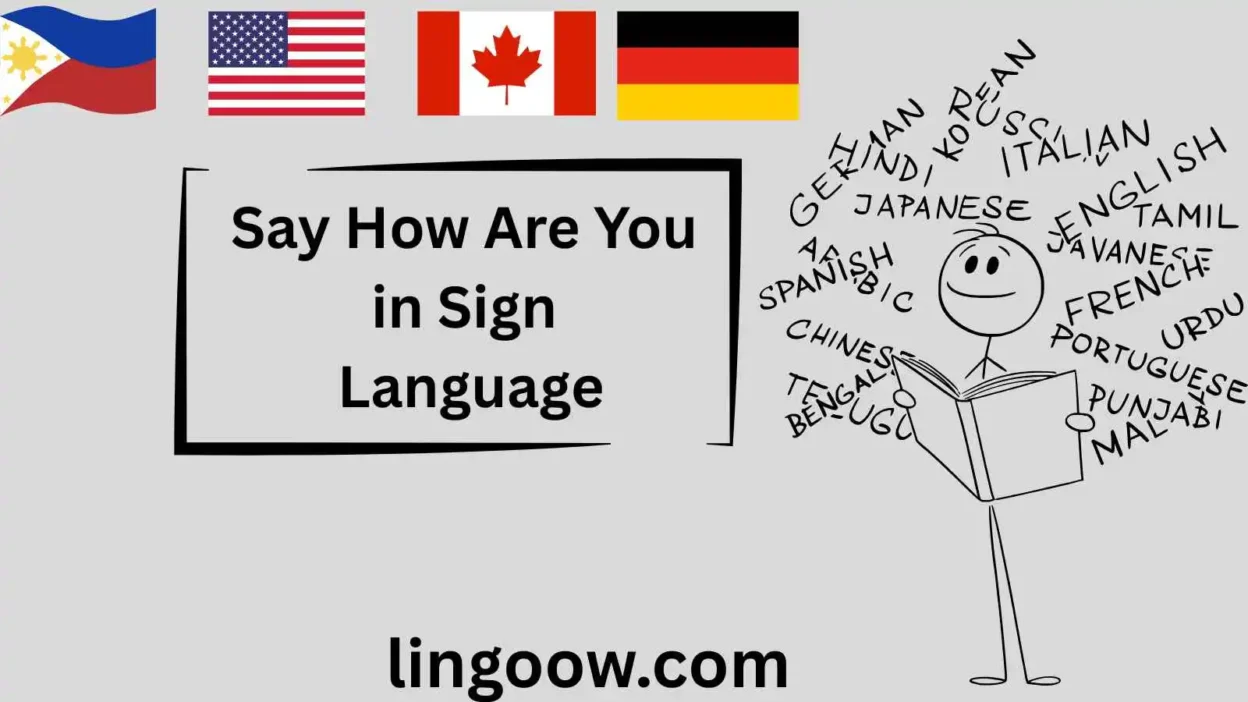I still remember the exact moment.
I was in a noisy café in Lisbon, struggling with my terrible Portuguese, when an unless man at the next table noticed my frustration. He didn’t speak English. I didn’t speak Portuguese. But instead of looking away (like most strangers do), he gently tapped his chest with an open hand, raised his eyebrows, and tilted his head slightly – a silent, universal question: How are you?
No words. Just a heartbeat of genuine care.
In that instant, I realized something profound: asking “How are you?” is one of the most human things we do. And across the planet, in thousands of spoken languages and hundreds of sign languages, people have found endless ways to ask the same tender question.
But today, we’re going deeper than spoken words.
We’re exploring how you ask “How are you?” in sign language – not just one, but dozens of them from every corner of the world.
Because in sign language, the question isn’t just heard.
Let’s travel the world – handshape by handshape.
A Quick Reference Table
| Language | Sign Description (Simplified) | Cultural Note |
| American Sign Language (ASL) | Tap chest with open hand → raise eyebrows → “YOU” (point) → “OK?” (thumbs up, questioning face) | Heavy use of facial expression – the raised eyebrows ARE the question mark. |
| British Sign Language (BSL) | Two-handed: both hands make “Y” shape near shoulders, rock forward with questioning face | Very different from ASL despite shared spoken language – shows how sign languages evolve separately |
| French Sign Language (LSF) | Open hand taps chest twice, then circles forward with questioning expression | Considered one of the most “elegant” sign languages – graceful, flowing motions |
| Japanese Sign Language (JSL) | Tap chest with flat hand → point to other person → make small circle near face with questioning look | Deeply tied to Japanese politeness culture – the face shows humility and care |
| Korean Sign Language (KSL) | Two fingers (index + middle) tap chest twice → point to person → tilt head with soft eyes | Often accompanied by a slight bow of the head – respect is visual too |
| Auslan (Australian) | Similar to BSL but with one hand: “HOW” (fist on chin) + “YOU” + questioning face | Huge regional variation even within one country |
| Langue des Signes Québécoise (LSQ) | Chest tap → “YOU” → open hand circles toward person with raised brows | Influenced by both ASL and LSF – a beautiful linguistic bridge |
| Irish Sign Language (ISL) | Tap chest → two-handed “YOU” → questioning expression | One of the few sign languages with gender-distinguished signs in some contexts |
| Italian Sign Language (LIS) | Open hand on chest → flick wrist forward toward person with head tilt | Expressive and theatrical – matches spoken Italian passion |
| German Sign Language (DGS) | Flat hand on chest → point to person → “HOW-GOES” (hand moves forward) + questioning face | More structured and precise – reflects German linguistic tendencies |
| Brazilian Sign Language (Libras) | Both hands tap chest → “YOU” → open palms up with questioning face | Warm, expansive movements – reflects Brazilian emotional openness |
| South African Sign Language (SASL) | Tap chest → “YOU” → make “OK” handshape and shake slightly with raised brows | 11 official spoken languages → SASL acts as a unifier |
| Mexican Sign Language (LSM) | Tap chest → point → open hand circles near face | Strong influence from indigenous gesture systems |
| Russian Sign Language (RSL) | Hand on chest → point → questioning face (eyebrows up, head forward) | Very direct eye contact – considered polite and sincere |
| Israeli Sign Language (ISL) | Chest tap → point → open hand near face with questioning expression | Relatively young language (developed in the 1930s–40s) with multiple influences |
| New Zealand Sign Language (NZSL) | Two-handed “HOW” near chin → “YOU” → questioning face | Officially recognized as one of NZ’s three official languages |
| Swedish Sign Language (SSL) | Flat hand on chest → point → head tilt + raised eyebrows | Minimalist and clear – reflects Scandinavian design sensibility |
| Thai Sign Language (TSL) | Hands in prayer position (wai) → slight bow + questioning smile | Deeply rooted in Thai respect culture – the wai gesture is sacred |
| Arabic Sign Language (ArSL – unified) | Hand on chest → point → open palm up with head tilt | Varies greatly by country, but chest-hand + heart connection is common |
| Indian Sign Language (ISL) | Namaste hands → slight bow + questioning eyes | Influenced by cultural greeting gestures – namaste means “I bow to the light in you” |
| Inuit Sign Language (IUR) | Tap chest → point → raise eyebrows dramatically | Used in extremely harsh climates where spoken words can freeze – visual clarity is life-saving |
| Hawaiian Sign Language (HSL) | Shaka sign (pinky + thumb) near face + head tilt | Nearly extinct, but being revived – tied to aloha spirit |
| Plains Indian Sign Language (historical) | Hand over heart → sweep toward person + questioning expression | Once a trade language across dozens of cohorts – used across vast distances |
| Yolngu Sign Language (Australia) | Complex hand movements referring to kinship + emotional state + questioning face | Used by both deaf and hearing in some Aboriginal communities – one of the oldest sign systems |
| Ban Khor Sign Language (Thailand) | Village-specific signs using home and family references + questioning face | A rare “village sign language” – emerged in a community with high deafness rates |
Europe
Even though France, Germany, and Britain are neighbors, their sign languages are as different as Mandarin and English. Why? Because sign languages aren’t visual versions of spoken languages – they’re born from deaf communities.
French Sign Language (LSF) gave birth to ASL, Russian Sign Language, and many others – but British Sign Language? Completely unrelated. When you watch a BSL signer ask “How are you?”, it feels like a different world from ASL, even though both countries speak English.
Asia
In many East Asian sign languages, the question “How are you?” is almost inseparable from respect. Even the speed matters: rushing the sign can feel rude.
Arabic Sign Language (in its many regional forms) often places the hand over the heart first – because in Arab culture, sincere questions come from the heart, not just the mouth.
Africa
In many African deaf communities, “How are you?” is less about your personal mood and more about your place in the community. South African Sign Language users might add signs for family, ancestors, or village before asking about you – because a person is never just an individual.
In Ghanaian Sign Language, the question is often accompanied by a warm hug gesture – even if you’re standing ten feet apart.
Indigenous & Island Worlds
Some of the oldest sign languages aren’t in cities – they’re in deserts, islands, and plains.
- Yolngu Sign Language (Arnhem Land, Australia) has been used for tens of thousands of years by both deaf and hearing people during mourning periods when speech is forbidden.
- Plains Indian Sign Language once allowed Lakota, Crow, Cheyenne, and Arapaho traders to communicate across hundreds of miles.
- Martha’s Vineyard Sign Language (extinct now) was used by nearly everyone on the island in the 1800s – hearing and deaf alike – because of a genetic deafness rate of 1 in 25.
These weren’t “disability languages.” They were full community languages.
Cultural Insights
In almost every sign language, the hand touches the chest first.
Why?
Because across continents and centuries, humans have agreed (without ever signing a treaty) that caring about someone else’s well-being starts at the heart.
That single gesture – hand on chest – appears from Inuit communities in the Arctic to Bedouin signers in the desert.
Beautiful Proverbs & Sayings About Asking “How Are You?”
- Zulu proverb (translated): “A person is a person because of other people.” (Ubuntu) – You cannot ask “How are you?” without implying “I am here with you.”
- Japanese saying: “Asking ‘Are you well?’ is the beginning of all politeness.”
- Hawaiian: “Aloha asks the question before it is spoken.”
- Persian poetry (Rumi): “Out beyond ideas of wrongdoing and rightdoing, there is a field. I’ll meet you there… and ask, how is your heart?”
FAQs
Why don’t all sign languages look the same?
Because they grow from deaf communities, not hearing ones. Two neighboring countries can have completely different sign languages.
Is there an International Sign Language?
There’s “International Sign” – a simplified contact system used at global events – but it’s not a real language. It’s more like pidgin.
Which sign language is the “oldest”?
We don’t know for sure, but some Australian Aboriginal sign languages may be 40,000+ years old.
Can hearing people use these signs?
Absolutely. And when you do, you’re speaking with your whole self.
Final Thought
Every day, millions of hands rise to chests.
Millions of eyebrows lift.
Millions of silent questions float across classrooms, villages, and city streets:
How is your heart today?
No matter where you are, someone is asking it right now – maybe with fingerspelling, maybe with a single raised brow, maybe with a gentle tap over their heart.
So here’s my question to you:
How do YOU say “How are you?” – in your language, your sign language, your family’s secret gesture?




